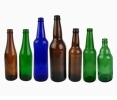Glass Bottle Packaging Trends in the Industry
Jul 16,2025
927
The glass bottle packaging industry is continuously evolving, incorporating new technologies and designs to meet consumer demand and environmental concerns. In recent years, the sustainability movement and advancements in material sciences have spurred innovative trends in glass bottle packaging. As brands and manufacturers strive to stay competitive, these trends are reshaping the industry. This article will explore recent developments in glass bottle packaging and how they’re influencing the market.
Demand for Sustainability
One of the most significant trends in the glass bottle packaging industry is the increasing demand for sustainable and eco-friendly packaging solutions. Glass, being inherently recyclable without loss in purity or quality, satisfies consumer and industry demands for sustainability. Brands are increasingly highlighting their commitment to the environment by opting for glass bottle packaging, which can be recycled indefinitely, reducing the impact on landfills and conserving natural resources.
Innovation in Glass Bottle Design
Innovation in glass bottle design is not only about aesthetics but also functionality. Ergonomic shapes, unique textures, and novel ways of dispensing products are becoming more prevalent. Designers are creating glass bottles that are not just containers but also part of the product experience, enhancing the user interaction and brand perception.
Utility Meets Aesthetics
Glass bottles are no longer just storage containers; they are now crafted to offer a combination of utility and aesthetics. Manufacturers are utilising various colour treatments and design elements to differentiate their products on the shelves. From elegant silhouettes to intricate embossing, these design elements are pivotal in branding and creating an appealing visual impact.
Advancements in Glass Durability
Contrary to the common perception of glass as fragile, advancements in material sciences have led to the development of more durable and lightweight glass bottles. These innovations offer the same visual appeal and recyclability of traditional glass while reducing transportation costs and the risk of breakage.
Adoption of Specialised Glass Types
Another trend gaining traction is the adoption of specialised glass types for packaging. Innovative solutions like miron violet glass bottles protect the contents from harmful effects of light, thus extending the shelf life of sensitive products. This preservation quality is especially advantageous for products like essential oils, pharmaceuticals, and high-end beverages.
Functionality Through Bespoke Dispensing
The rise of tailored dispensing solutions in glass bottles is a response to the growing market diversity. For instance, glass dropper bottles offer precise dosage and application, which is particularly beneficial for products such as serums, tinctures, and essential oils. These functional designs are both practical and conducive to enhanced user experiences.
Coloured Glass for Product Preservation
There has also been an upsurge in the use of coloured glass bottles as companies recognise their aesthetic and protective qualities. Amber glass bottles are utilised widely in industries like brewing and pharmaceuticals, where they prevent UV light from degrading light-sensitive products. The appeal of coloured glass bottles extends beyond protection; it also carries an artisanal quality that many consumers find attractive.
Personalisation and Branding
As the market becomes more saturated, personalisation and branding through glass bottle packaging have become essential for differentiating products. Companies are investing in custom moulds and finishes to create signature bottles that align with their brand identity and ethos. Furthermore, incorporating elements like logos and brand-specific motifs into the glass bottle design fortifies customer recognition and brand loyalty.
Shift Towards Minimalism
The minimalist design trend has made its way into the glass bottle packaging industry. Simplistic labels, transparent glass, and clean lines are becoming popular as they convey a message of purity and quality. This shift towards minimalism in packaging reflects a broader consumer trend favouring straightforward, honest branding.
Integration of Smart Technology
Smart technology integration is an emerging trend in glass bottle packaging. NFC tags, QR codes, and other digital elements are being incorporated into the glass packaging to engage customers, provide additional product information, and create an interactive experience. It is a powerful tool for brand storytelling and authenticity verification.
Enhanced Labelling Solutions
Advances in labelling technology have granted glass bottle manufacturers the ability to incorporate vibrant and intricate labels that can withstand the rigours of distribution and retail environments. New adhesives and label materials ensure that the branding remains pristine and prominent throughout the product’s lifecycle, giving glass an edge as the preferred packaging material.
Eco-Friendly Closure Options
The trend towards sustainability in glass bottle packaging extends to closures as well. Corks, bamboo, and other biodegradable materials are gaining popularity as eco-friendly alternatives to synthetic stoppers. The packaging industry is exploring and implementing these natural options to ensure every aspect of the product aligns with green principles.
Emphasis on Reusability
Reusability is also a prime focus in the current glass bottle packaging trends. Consumers are looking for products that offer secondary uses once the original contents are depleted. Glass bottles are ideal for repurposing, which adds value for the consumer and reflects positively on the brand’s environmental ethics.
In conclusion, the glass bottle packaging industry is experiencing a dynamic transformation influenced by the demands for sustainability, innovation, and personalisation. The trends mentioned above are some of the driving forces behind the continuous evolution of glass as a packaging material. Adopting these trends not only meets the needs and expectations of modern consumers but also exemplifies a brand’s commitment to quality and environmental responsibility.
Source:nerdbot.com
Author:shangyi
Read More
Related News
-
Glass Bottle Packaging Trends in the Industry
Jul 16,2025
-
Fire at Stoelzle Flaconnage's UK glass plant
Jul 15,2025


